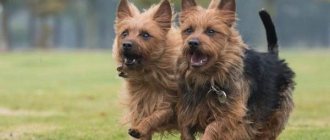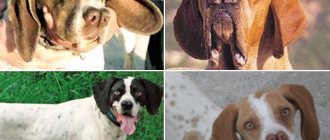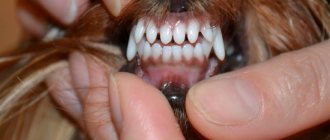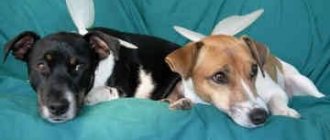Why does a dog grunt as if it is suffocating?
An animal can wheeze for various reasons. Sometimes this happens due to the characteristics of the breed, in some cases due to illness or a foreign body entering the throat. For example, everyone knows that Yorkies pant quite often. The reasons for this may vary.
Feature of the breed
The brachycephalic group includes a sufficient number of breeds. A common characteristic feature of pets with this name is a shortened, sometimes too flattened front part of the head. Due to this anatomical structure of the muzzle, the pet has to constantly snore, sniffle, cough, sniffle, grunt or snort and even grunt.
This process does not depend on whether the dog is in a state of rest or physical stress. It is difficult for them to inhale air using a shortened nasopharynx, unlike their relatives who have elongated muzzles. Based on this, it becomes clear why the Spitz grunts. For the same reason, the Pekingese dog has a hoarse voice.
Veterinarians distinguish certain dog breeds with anatomical features. Signs may appear in:
- pugs;
- Pekingese;
- boxers;
- bulldogs;
- mastiffs;
- Shar Pei;
- Shih Tzu;
- Japanese Chins;
- Dogues de Bordeaux;
- griffins;
- Pomeranians;
- Chihuahua.
Chihuahua is one of the breeds with physiological characteristics
Entry of a foreign object
Suspicious gurgling sounds in an animal can also be caused by small debris or a large foreign object getting into the throat.
The presence of foreign objects in the nasopharynx is a common occurrence, especially given the dog's tendency to sniff everything around. Depending on the exact position of the interfering debris inside, the pet owner may hear signs of whistling, snorting, and even grunting. This condition is dangerous, as the animal cannot breathe normally, begins to sneeze and literally suffocates in front of the owner. Important! To provide first aid, you need to fix the dog's head and try to reach the cause of the symptoms with tweezers.
Helminth infection
Despite the fact that the first organ that suffers from helminths is the intestines, parasites can infect the lungs and liver. If a colony of worms affects the lungs, the dog's regular breathing will be disrupted. In this case, the pet may grunt or snore in its sleep.
Note! The presence of pulmonary parasites in puppies can be fatal. After all, the tissues of the organ are destroyed, and the dog can suffocate.
It is impossible to help a pet without consulting a specialist. Every day the form of the disease develops, bringing the dog closer to severe pneumonia and pneumonia.
Tumor
The tumor contributes to disruption of the functioning of the lungs and respiratory tract. In such a situation, the Yorkie often grunts. The dog owner should be wary if:
- while breathing, the pet gradually develops a gurgling or whistling sound;
- the animal has a cough, difficulty in inhaling or exhaling air;
- the dog’s general condition worsens, it becomes lethargic, apathetic, and sometimes refuses food;
- The dog has a runny nose with bloody mucous discharge and particles of destroyed tissue in the usual exudate.
Tracheal collapse
This is an unpleasant pathological process. Its characteristic feature is that it appears suddenly and develops unpredictably. Due to the disorder, the trachea quickly narrows, sometimes decreasing to parameters that impede the passage of air. Due to the narrowing of the lumen of the organ, the pet may experience grunting, snoring or wheezing. Sometimes the owner hears sounds that resemble quacking.
Reverse sneezing
Experts suspect that the reason for sneezing not outward, but inside the dog’s body, lies in the genetic predisposition of brachycephalic breeds. After all, about 90% of cases were recorded in this category of pets. Often the attack lasts 5-10 seconds, after which it disappears without a trace.
On a note! To find out the cause of the condition, it is recommended to conduct a full examination of the dog by a veterinarian.
Paroxysmal breathing (reverse)
In addition to grunting, sniffling and wheezing, this disorder may be accompanied by the following symptoms:
- the dog tries to spread his paws wide and arch his back inward;
- redness and bulging of the eyes appear;
- The dog actively shakes its head to the sides and scatters particles of saliva around.
Heart failure
The dog's wheezing and grunting may occur due to acute heart failure. Additional symptoms of the disease include:
- a sharp decrease in blood pressure;
- arrhythmia;
- trembling all over the body.
Types of wheezing in dogs
Not in all cases, dog snoring is characterized by the same sound, therefore, based on what is heard, it will be easier for the owner to determine the root cause of this phenomenon and select effective methods to solve the problem.
There are several main types of wheezing in pets:
- Dry - usually explained by a narrowing of the lumen in the bronchi or trachea, which, in turn, can be caused by the presence of too thick secretion. Unusual sounds are clearly audible both when inhaling and exhaling, although in the latter case they reasonably seem louder. Dry wheezing is often observed when the airways are obstructed due to a foreign object getting into them or due to bronchitis.
- Moist rales appear as a result of the accumulation of various organic fluids in the lungs or respiratory tract: blood, mucus or purulent exudate. Since air is forced to pass through them when inhaling or exhaling, its movement slows down significantly, and the process itself is accompanied by gurgling sounds. This sound is usually observed with pulmonary hemorrhage, edema, and bronchopneumonia.
- Creeping rales are characteristic when the alveoli are expanded with air. They are often heard on exhalation if the dog has pneumonia or is suffering from fibrosis.
- Inspiratory wheezing, also often heard as a whistle, is loud breathing that is usually caused by a narrowing of the airways. This symptom is characteristic of brachycephalic syndrome, paralysis of the vocal cords, and can also appear as a result of a foreign body entering the trachea.
What symptoms should you be wary of?
If a Spitz is choking and grunting, the owner should be alerted to symptoms such as:
- cough;
- weight loss;
- dyspnea;
- vomit.
In this case, the breed of the dog that grunts does not matter. For any representative of four-legged animals, such symptoms will not be a joy.
A dog's cough is a good reason to visit a veterinary clinic.
Dog snoring in sleep
It is worth noting right away that snoring cannot be called a cardinal problem. The animal is probably hovering in its sleep, so it is quite predictable to make all sorts of unreasonable noises.
The next reason may be the difference between pets in terms of breed characteristics, for example, a pug is genetically prone to snoring and “grunting”. It is worth clarifying this in advance at the stage of choosing a puppy. Don't forget to look at the animal's diet. Excess weight is a fairly logical root cause of grunting.
The pug is genetically prone to snoring and grunting
The alarm should start sounding when the dog is unable to sleep due to nasal congestion. As a rule, along with this fact, various symptoms such as cough, weight loss, vomiting, and shortness of breath appear. In this case, you cannot do without visiting a veterinarian.
What to do if your dog grunts
If your dog is grunting, experienced dog breeders recommend:
- at the time of such an attack, gently stroke the pet’s throat;
- try to hold his nose; this way the dog will open its mouth and take a deep breath, which will help stop the symptoms from appearing;
- if the attack lasts a long time, perhaps a foreign object has entered the pet’s nasopharynx, the dog has had a heart attack or develops a respiratory disease, in which case the animal must be urgently taken to the veterinarian;
- if an object stuck in the throat is visible, you can try to get it out yourself;
- If your dog is short of breath due to fear in an unfamiliar or unpleasant environment, you can give him a sedative prescribed by a specialist.
Important! If symptoms recur frequently, it is recommended to undergo a course of special treatment.
Diagnosis of respiratory organs
There are many techniques that can help establish a diagnosis. These are instrumental, laboratory, hardware, functional methods.
Diagnosis of the respiratory system includes:
- Ultrasound of the respiratory system.
- Bronchography.
- Fluorography.
- Pleurography.
- Angiography.
- Bronchoscopy.
- Laryngoscopy.
- Thoracoscopy.
- X-ray, fluoroscopy.
- Auscultation, percussion, palpation.
- Serological tests.
- Histological studies.
- CT, MRI.
- Spirometry.
When establishing a diagnosis, the history data, conditions of detention, age, and breed characteristics of the dog are taken into account. In most cases, differential diagnosis is carried out to confirm and establish an accurate diagnosis.
Prevention measures
If, for example, a Spitz grunts and wheezes, as if it is suffocating, in order to avoid unpleasant symptoms you should:
- provide your pet with a balanced and varied diet;
- organize a room for keeping the dog so that it is warm, protected from winds and cold;
- do annual preventive deworming;
- double-check the sanitary and hygienic standards for keeping the animal.
A balanced diet is essential to maintaining your pet's health.
How can I help at home?
The dog must be provided with peace and not create additional stress on the respiratory system (avoid overheating, physical exertion, excitement). Provide fresh air flow (open a window). Under no circumstances should you try to put your dog down or give him water to drink - this can be dangerous. There is no need to use any drugs that stimulate breathing - in most cases this is not only pointless, but can also be harmful. It is necessary to take the animal to the doctor as quickly and carefully as possible.
When to contact a veterinarian
To find out why the Yorkshire Terrier grunts, or unpleasant symptoms appear in pets of other breeds, you need to contact a veterinarian if:
- bacterial or viral runny nose;
- allergic reactions;
- irritation of the mucous membrane;
- nasal congestion;
- obesity.
These diagnoses, together with all of these symptoms, can cause serious illness.
Sometimes a cute, grunting pug is not a funny dog, but an animal with health problems. The owner should monitor the condition of the pet so as not to trigger a possible disease.
Clinical and home treatment
Treatment methods are selected on an individual basis. The veterinarian, having established the root cause and diagnosis, prescribes effective appropriate treatment for the dog.
Animals are prescribed antiviral, anti-inflammatory, sedative drugs, anthelmintic drugs, immunostimulants, complex antibiotics, sulfonamides, vitamins, and homeopathic remedies.
Antihistamines, corticosteroids (treatment of asthma), antitussives, cardiac glycosides, and pacemakers are used in therapy.
To eliminate attacks of suffocation and allergic reactions that provoke swelling of the larynx, the pet is prescribed Ephedrine, Suprastin, Diphenhydramine, Papaverine, No-shpu, Solutan in injections and tablets. In some cases, artificial ventilation of the dog's lungs is indicated.
If breathing is difficult due to a cold, vasodilators, antibacterial medications, restoratives, and immunomodulators will help normalize the condition.
- Surgical treatment is prescribed to eliminate congenital defects, tracheal collapse, polyps in the nasopharynx, and neoplasms.
- If there are foreign bodies in the respiratory tract, they are removed with special tools and devices.
- In severe cases, the pet is prescribed lifelong maintenance therapy.
Trembling or grunting
If you notice that your pet is trembling, in such a situation the first and natural question arises, why this is happening and what needs to be done.
Let's look at the most common cases:
- Cold. Because the Yorkshire Terrier is small in size, the animal is very susceptible to low temperatures. You can keep your Yorkshire Terrier warm during a walk using special clothing. At home, you can turn on the heater or give your pet a blanket; the reason why a dog is trembling may be fear or fright; an excited state or excitement may be the answer to a question; low blood sugar; if the dog trembles after eating, especially when switching to a new food or while taking medications, then an allergic reaction can be judged; in some cases, the animal trembles due to poisoning. Additional symptoms of the disease include diarrhea, weakness, and apathy.
Another common question that worries owners is why the dog grunts and what to do about it. In some cases there is no serious reason to worry.
Veterinarians explain that a dog can make similar sounds if there is nasal congestion, heart disease and heart failure. Sometimes a dog grunts when excited.
Causes of shortness of breath and grunting
Why is this happening? Veterinarians identify several main reasons for this condition in pets:
Reverse sneezing. The dog suddenly chokes, has the urge to vomit, and grunting sounds come out of its mouth. The condition is not dangerous and goes away quickly.
Entry of a foreign object. The dog cannot breathe, wheezes, grunts. This happens while walking or playing. Requires immediate veterinary attention.
Heart problems. Sick dogs suffocate after physical exertion; symptoms develop gradually and are more typical for older dogs. Along with shortness of breath, the animal's tongue turns blue and foam comes out of the mouth.
Pulmonary edema. It develops gradually, with cardiac pathology, or acutely, due to poisoning.
Anxiety and stress. It happens that a dog begins to grunt and choke during a thunderstorm, fireworks, before visiting the veterinarian and in other difficult situations. The condition is not dangerous and does not require assistance.
Dogs can be negatively affected by excessive exercise and may experience shortness of breath. If this happens constantly, you should have your heart checked.
Helminths that attack organs. The symptoms are similar to other diseases of the cardiovascular system; a veterinarian will help establish the diagnosis.
Polyps and tumors in the larynx. Grunting develops gradually and intensifies with physical activity.
Colds, pneumonia. The dog cannot breathe through his nose due to snot, and his temperature rises. When pneumonia or bronchitis occurs, a cough is associated.
Sometimes bitches grunt and gasp before giving birth. This is not dangerous to their health. Shortness of breath, trembling and convulsions after the puppies are born should be a concern. Such symptoms indicate incipient eclampsia.
Owners should pay special attention if attacks of shortness of breath and grunting are repeated frequently. In this case, you should definitely take your dog to the doctor. He will determine why the pathological condition occurred and prescribe treatment.
When a dog itches
If your pet is actively itching, then this symptom may be ambiguous. The first step is to examine the dog for the presence of fleas, from which it is impossible to protect even the cleanest animals. Parasites and their larvae can enter the house with people's shoes.
It is necessary to remove fleas not only from the animals themselves. Fleas and their larvae can be in any objects that the dog comes into contact with.
All things need to be vacuumed well, shaken out in the fresh air, and washed if possible. Fleas can be removed using products specifically designed for this purpose.
The veterinary pharmacy offers products to kill both adult fleas and prevent re-infection. An anti-flea collar helps to combine both methods of getting rid of the disease.
Since they tend to multiply quickly, if you do not start fighting them immediately after they are discovered, after 1-2 weeks the animal will seriously suffer from an entire army of fleas.
To remove them completely, as a rule, a repeat procedure is required. The re-processing period is indicated in the instructions. Fleas can go without food for a long time.
Some time after treating the animal itself and the bedding, fleas may appear again.
If the animal itches, but there are no fleas, then the discomfort may be caused by cutting the fur. If your pet still continues to itch and bites its paws, then the animal may have liver and heart diseases. To clarify the situation, the help of a veterinarian is required.
Not only fleas, but also other parasites can cause suffering. You need to inspect the fur especially carefully during the tick season.
Allergies can also cause itching. Dry food should be limited in your pet's diet.
Carefully inspect the skin for splinters or other foreign elements trapped under the skin.
Common diseases
They are considered one of the smallest and most fragile breeds. Most often, Yorkshire terriers are bothered by such diseases as:
- dislocated kneecaps; allergic reactions; decreased blood sugar levels; liver and pancreas diseases; diseases of teeth and gums; tracheal collapse; retinal dysplasia.
Let's take a closer look at some of the diseases of Yorkshire terriers, their symptoms and possible preventive measures.
Tracheal collapse is not only a problem for Yorkies, but also for many other small breed dogs. This disease consists of a narrowing of the trachea, which makes it difficult for the animal to breathe.
The disease occurs when the cartilage rings soften. It can also occur as a result of pressure from the collar or due to impaired metabolism. Symptoms are a persistent cough and shortness of breath.
Tracheal collapse can be treated not only surgically, but also with medication.
This disease can affect not only the respiratory, but also the cardiovascular and nervous systems. You can detect it by feeling your neck with your fingers.
However, radiography is most often used to diagnose the disease. Ultrasound diagnostics and tracheoscopy will also help identify the disease.
Every owner notices certain symptoms in their pet from time to time. Let's look in more detail at whether this is normal and what needs to be done to eliminate them.
If a dog sneezes, this indicates irritation of the nasal mucosa. Brief sneezing, with no other changes in behavior, indicates the absence of serious illness.
Your Yorkshire Terrier may be sneezing from dust or pollen inhalation. If your pet sneezes only a few times, especially after sleep, it may be a reaction to irritants such as tobacco smoke, dust, perfume, or air freshener.
Prolonged sneezing accompanied by other symptoms, such as lethargy, refusal to eat, or restlessness, may indicate a cold or viral illness.
In this case, you should immediately contact your veterinarian. These symptoms are inherent in a disease such as tracheobronchitis. It can be contracted through contact with other animals. Early vaccination will help prevent the disease.
If sneezing continues for a long time, but the behavior remains normal, then an allergy can be assumed.
The first step is to identify the cause of the allergic reaction, otherwise it may result in complications.
If your dog sneezes and tries to scratch his nose and produces fluid or blood, most likely a foreign object has entered his nose. It is best to contact a specialist so as not to injure your pet.











